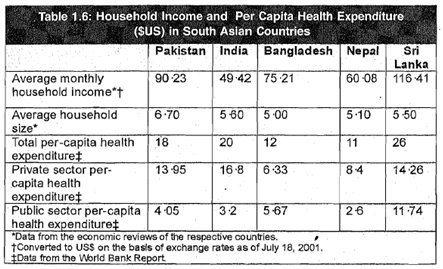Explain the Economic and Social Burden ?
Cardio-vascular diseases pose tremendous economic strain on the population and the countries throughout the world. However there is a disparity between the developing and the developed nations. In the developed nations the incidence is rising but not alarmingly and the resources are available (though not equitably distributed) Lo tale suitable measures for treatment and prevention. On the other hand, developing nations are pacing almost a silent epidemic of CAD and access to health care is severely restricted because of low availability and high cost.
According to World Bank dollar-a-day estimates, of the 1.3 billion people living below the poverty line worldwide, 40 per cell1 (5 15 million) live in South Asia, and the gross national product per capita in that region is only US$393, compared with $1 250 for the rest of the developing world (Table).

India spends about 5 percent of its gross domestic product (GDP) on health, of which direct private expenditure on health is about 82-83 per cent and the subsidized government expenditure is 17-1 8 per cent. It is quite understandable that any disease that is as prevalent as CAD would appropriate a substantial portion of that expenditure. Though normal calculations exist regarding the economic burden of CAD, in a study reported in Indian Hear1 Journal in 21105, the economic burden has been calculated as about Rs. 200 billion and that also as an underestimate. Considering that the annual GDP of India is about Rs. 25000 billion, the burden of CAD in India is about 0.8 per cent of GDP. This is purely the direct cost of treatment and does not include the cost in terms of loss of man-hours and wages, which if added up would make the total burden a colossal figure. This is nothing but an economic waste as almost 80 per cent of the heart attacks are preventable by appropriate management and prevention strategies.
The social burden of CAD is also not difficult to comprehend. In Indians, acute coronary events occur at least 10 years earlier than ill Caucasian and Latin American countries and five years earlier than in China. This means that CAD affects Indians mostly in their productive years. Premature CAD therefore causes significant social burden in terms of loss of job and support for young children, women and the elderly. The exact cost to a family of such a catastrophe is again difficult to estimate but the DALY (disability adjusted life years) calculation include burden of prepare morbidity on the individual and clearly shows that CAD contributes to a large measure to it in India.
While CAD is definitely the major problem in the country, the two other conditions also require special mention and those are the burden imposed by Hypertension and rheumatic heart disease.